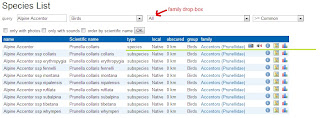
I am a volunteer admin for the Biodiversity website
http://observado.org. I am still very excited about the project, so let me tell you something about it. I will start with it's history and then I will explain you something on how it works (please scroll down if you're not interested in it's history). Observado.org is a spin-off project of the very succesfull dutch website
http://waarneming.nl. The project started in August 2003, with a question on the EBNNL (eurobirdnet Netherlands) internetforum. The question was about how to get information on what birds were seen in which Dutch nature reserves. If you wanted to visit an area, what could you expect? In August 2003, on EBNNL it was proposed tot create a national database, where you could enter, retrieve and share sightings of birds. The database should be easy to use and had to be open to everybody, from laymen to experts. Founding fathers Hisko de Vries and Dylan Verheul teamed up with the foundation "Stichting Natuurinformatie"and together they built Waarneming.nl. (I joined in the winter of 2005/ 2006 as volunteer when I organised a national count of Waxwings, during a large irruption of this species in Western Europe. We used Waarneming.nl as the platform where people could enter their waxwing sightings).
Growth went fast and by 2005 it was clear that birds weren't the only thing, users were interested in. So other groups were added. Mammals, amphibians, ... I myself entered the first Fungus sighting, plants, etc.. The possibility of entering pictures and sounds were improved as was the way you could enter a sighting. With the use of google maps, it became possible to point on a satellite map, where exactly you did the sighting. This was off course phenomenal and improved the distribution maps enormously! Sightings are checked by experts, called admins or validators. Within 5 years time, the distribution maps on Waarneming.nl, were often better than the ones that were gathered in the 20 years before. It appeared that single sightings could give a lot of information, something probably not many people had expected.
Enough about Waarneming.nl, let's talk about Observado.org!
The dutch observers didn't only see animals/ plants/ ... within the Netherlands, they also visited countries abroad. They wanted to have a platform where they could enter and share these sightings. Since they were already using waarneming.nl, why shouldn't there be an international version?
Observado.org is open to everybody from all over the world, so not only for Dutch users. So whether you're from Spain, Brazil, Japan, South-Africa or whatever country, you could all join and share your biodiversity observations! Every observation is interesting, so not only the rare species! The large amount of pictures and sightings will give information on the variation within species, will improve the distribution maps and can help people to identify species.
So what does it look like and what could you do with it?
First of all, change language to english in the top right corner when you open Observado.org. Secondly you could always have a look at the observations that are already in the database, also without signing in. But if you want to enter your own observations you have to log in. Signing up is free. The reason why observado asks for signing in, is to keep the data clean of errors and nonsense observations. If we (admins) find an error or a strange observation, we can contact the observer and ask him/ her to change or delete the observation.
If you do decide to enter observations on Observado.org, there's many extra's you could use (like keeping your own lifelists, search in your own photostream, enter sound recordings, etc. etc.).
Now on tour!
(I give some links, best is to right click on them and open them in a new tab).
startpage This page shows recent rarities added from all over the world
On top of this page, you'll find the menu tabs (under "Observado.org"):
In the search bar, you could search for specific species. Make sure you enter the correct speciesname (or part of the speciesname) otherwhise it won't find the species you are looking for. Let's start searching for the global species Osprey:
Enter osprey in the search bar, and you'll retrieve:
Two species, let's take osprey:
Click on the speciesname and you'll get all the osprey sightings in Observado.org:
(if you look at province, you could chose a country)
Okay, let's say we're interested in pictures of this species. If you look in the menu top right "about this species", you see "photos"
Also have a look at "information"! Information is a selection of the pictures, with focus on identification and variation.
My own sighting of an osprey (I didn't include the google map):
Try also clicking on the familiy name of a species! This will show you the other family members.
Just try things out by clicking on them! That's the best way to find out how it works! I might write some more about this in the future.
Good luck!
Wouter












 It had chosen a small orchard with appletrees. One old tree had still a lot of apples on its branches. And about 15 Blackbirds, one Fieldfare, a few Starlings and one Mistle Thrush were feasting on these apples. Especially on the ones that were fallen below the tree.
It had chosen a small orchard with appletrees. One old tree had still a lot of apples on its branches. And about 15 Blackbirds, one Fieldfare, a few Starlings and one Mistle Thrush were feasting on these apples. Especially on the ones that were fallen below the tree.



